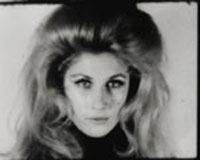“The many Screen Tests evidence a variety of behavior of its portrait subjects, but amazingly little improvisation. The subjects actually look like they are captured and about to be interrogated, but the interrogation never happens, because Andy wanted to capture the essence of the person only, no interference, just like no interference with the camera as it recorded each “moving†still-life. The “Screen Tests†rank in the Warhol pantheon along with the Campbell’s Soup cans, Marilyns, and self-portraits.â€
Billy Name-Linich, Factory photographer (1)
| Screen Tests 1964 – 1966
Andy Warhol’s Screen Tests were filmed from early 1964 – November 1966 (GM25). Factory visitors who had potential “star” quality would be seated in front of a tripod mounted camera, asked to be as still as possible, and told not to blink while the camera was running. |
|
| Subjects included factory Gerard Malanga, filmmaker Barbara Rubin (1964), filmmaker Jonas Mekas (1964), filmmaker and poet Piero Heliczer (1964), poet Allen Ginsberg (c.64/65), John Ashbery (1965), Italian model model and one time girlfriend to Gerard, Benedetta Barzini (1966), Francesco Scavullo (1965), Phoebe Russell (1965), model/actress/granddaughter of designer Elsa Schiaparelli Marisa Berenson (1965), Nico (1966), Lou Reed (1966), John Wieners, Bob Dylan, Ingrid Superstar, Edie Sedgwick (1965), Ivy Nicholson, Danny Fields, Billy Name, Salvador Dali (1966), Donovan (1966), Charles Henri Ford (who was responsible for introducing Andy to Gerard) (1966), Rene Ricard (1966), poet Willard Maas (1966), Baby Jane Holzer, Phoebe Russell (1965), International Velvet (Susan Bottomly)(1966), Marie Menken – filmmaker/wife of Willard Maas/star of Chelsea Girls)(1966), Italian millionaire publisher Giangiacomo Feltrinelli (Benedetta Barzini’s stepbrother) Nov. 66, poet Ted Berrigan (1966), Allen Midgette (1966) Anne Buchanan (early ’64), and Andy’s first superstar Naomi Levine. .. (read on) | |
“The resulting films drastically reduced the roles of director and viewer alike. The director’s function was limited to choosing the subject, setting up the shot, turning the camera on and off and deciding whether or not to exhibit the result. And the viewer, for the first time in the history of the commercial exploitation of persistence-of-vision, was relieved of the obligation—perhaps even a large part of the desire—to pay attention to the screen. The standard ‘film-as-wallpaper’ definition of the early Warhol films doesn’t stand up, since their entire meaning and effect spring from the fact of their projection on a screen in a darkened room.â€
Tony Rayns, writer in “Andy Warhol: Film Factory†(2)
… according to ‘the warhol: resources and lessons’:
| Warhol’s Screen Tests are revealing portraits of hundreds of different individuals, shot between 1963 and 1966. The subjects include both famous and anonymous visitors to Warhol’s studio, including poet Allen Ginsberg, actor Dennis Hopper, and artist Salvador Dali, along with many other diverse individuals. |  Andy Warhol, “Screen Test: Jane Holzer,” 1964. 16mm film, black and white, four minutes, Collection of The Andy Warhol Museum, Founding Collection, Contribution the Andy Warhol Foundation for the Visual Arts, Inc. © 2006 The Andy Warhol Museum, Pittsburgh, All rights reserved. |
| When asked to pose, subjects were lit and filmed by Warhol’s stationary 16mm Bolex camera on silent, black and white, 100-foot rolls of film. Each Screen Test is exactly the same length, lasting only as long as the roll of film. The standard formula of subject and camera remaining almost motionless for the duration of the film, results in a “living portrait.†The films, projected in slow motion, last four minutes each. Outside of Warhol’s standardized process there are subtle lighting and focus variations in the Screen Tests. Jane Holzer’s is in soft focus and suffused with light, creating an ethereal, hypnotic effect while Piero Heliczer’s is darker in mood. In addition, there are a number of Screen Tests that diverge from this format entirely, the sitter purposely moving, gesticulating, or using props.
These film portraits, referred to by the Hollywood term of “screen test,†were not created for the purpose of actually testing or auditioning actors. A traditional Hollywood screen test is a method used to judge whether an actor is suitable on film, and beyond that, if they are right for a specific character. Usually he or she is given a scene, a script, and instructions to perform in front of a camera. The director then watches the test to make a determination about the actor’s appearance and film qualities. In these short films, Warhol creates his own cache of “Superstars.†Superstars are actors interesting enough to carry a film on their own—not by playing a particular role but simply by being “themselves.†Some of the individual screen tests were selected for Warhol’s conceptual projects, such as “Thirteen Most Beautiful Women†and “Thirteen Most Beautiful Boys.†Screen Tests were also featured as part of the light show for his 1966 multi-media happenings, the Up-tight and the Exploding Plastic Inevitable. In these shows, The Velvet Underground and Nico performed their ear-splitting, urban-style drone music, accompanied by Superstar dancers bathed in colored lights in front of large projections of slides and Warhol’s films. |
|
“Beauties in photographs are different from beauties in person. It must be hard to be a model, because you’d want to be like the photograph of you, and you can’t ever look that way. And so you start to copy the photograph. Photographs usually bring in another half-dimension. (Movies bring in another whole dimension. That screen magnetism is something secret – if you could only figure out what it is and how to make it, you’d have a really good product to sell. But you can’t even tell if someone has it until you actually see them up there on the screen. You have to give screen tests to find out.)â€
Andy Warhol, The Philosophy of Andy Warhol, p. 63.(3)
(1),(2),(3) quotes from ‘the warhol: resources and lessons‘
